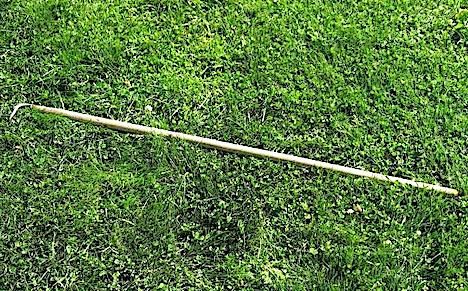
 2
2




Jay Angler wrote:Permies who have "time" just because of self-isolation may be a rarer breed than you think!
My online educational sites:
https://www.pinterest.ca/joelbc/homestead-methods-tools-equipment/
https://www.pinterest.ca/joelbc/mixed-shops/
 4
4




Visit Redhawk's soil series: https://permies.com/wiki/redhawk-soil
How permies.com works: https://permies.com/wiki/34193/permies-works-links-threads
 6
6














 2
2




Gary Bogdan wrote:So happy I found all these homemade gadgets !
My neighbor has a weld shop and would be Interested in sure . What I would like is an auger big enough to dig 2' wide holes so I could plant , say a quarter acre of berries and also plant a 3 sisters or 5 sisters garden , using the auger to dig the hills
My online educational sites:
https://www.pinterest.ca/joelbc/homestead-methods-tools-equipment/
https://www.pinterest.ca/joelbc/mixed-shops/






 2
2




Amber Adams wrote:This isn't something I've designed, but I recently came across this guy's YouTube channel and I'm definitely going to make his plastic bottle cutter
My online educational sites:
https://www.pinterest.ca/joelbc/homestead-methods-tools-equipment/
https://www.pinterest.ca/joelbc/mixed-shops/






 6
6






My online educational sites:
https://www.pinterest.ca/joelbc/homestead-methods-tools-equipment/
https://www.pinterest.ca/joelbc/mixed-shops/
 8
8




You are welcome to check out my blog at http://www.theartisthomestead.com or my artwork at http://www.davidhuang.org
 3
3




Silence is Golden
For all your RMH needs:
dragontechrmh.com






 3
3




David Huang wrote:At first I was going to metalsmith up something more complicated (and admittedly nicer all around) but then started thinking about the random stuff I already had on hand that could be cobbled together to make one. I post a shot of the stuff I started with, a vinegar container from the recycle bin, some longer screws and bolts, and a couple pieces of scrap grid beam I've been making for another project.
My online educational sites:
https://www.pinterest.ca/joelbc/homestead-methods-tools-equipment/
https://www.pinterest.ca/joelbc/mixed-shops/
 3
3




You are welcome to check out my blog at http://www.theartisthomestead.com or my artwork at http://www.davidhuang.org
 7
7




![Filename: syringe-ring.jpeg
Description: [Thumbnail for syringe-ring.jpeg]](/t/102321/a/122339/syringe-ring.jpeg)
Nails are sold by the pound, that makes sense.
Soluna Garden Farm -- Flower CSA -- plants, and cut flowers at our farm.
 2
2




Silence is Golden
For all your RMH needs:
dragontechrmh.com
 4
4




Nails are sold by the pound, that makes sense.
Soluna Garden Farm -- Flower CSA -- plants, and cut flowers at our farm.






 2
2




My online educational sites:
https://www.pinterest.ca/joelbc/homestead-methods-tools-equipment/
https://www.pinterest.ca/joelbc/mixed-shops/
 9
9




He whai take kore noa anō te kupu mēnā mā nga mahi a te tangata ia e kōrero / His words are nothing if his works say otherwise






 9
9




 8
8






You are welcome to check out my blog at http://www.theartisthomestead.com or my artwork at http://www.davidhuang.org
 5
5







You are welcome to check out my blog at http://www.theartisthomestead.com or my artwork at http://www.davidhuang.org
 5
5






You are welcome to check out my blog at http://www.theartisthomestead.com or my artwork at http://www.davidhuang.org






 3
3




My online educational sites:
https://www.pinterest.ca/joelbc/homestead-methods-tools-equipment/
https://www.pinterest.ca/joelbc/mixed-shops/
 2
2




wayne fajkus wrote:This is a log splitter i made and the plow type thing i made it from. I cut it out of plow. Forged the curve out to make it flat. Welded sucker rod handle to it. Quenched it.
It works well. I can beat on it pretty good. The handle gives me control
 4
4




Francis Mallet wrote:I've been wanting to share this for a while. It's called an "hypsomètre" in French but the English translation, hypsometer, isn't exactly the same tool (although they both do the same thing).
It uses the properties of similar triangles to measure the height of structures.
Mine is 28 inches long, the same distance from my eye to my fist. You can make the stick any length but matching it to your own size will simplify things (in this case a = b which means that a / b = 1).
To use: hold the stick vertically at arms length and move until it covers the whole object you want to measure. Mark the spot where you stand and count how many stick lengths between that spot and the object. If the stick is adjusted to your size then that distance is the object's height.
Here's an illustration that might help: Mesurer un arbre (ou autre élément vertical)
 3
3




You are welcome to check out my blog at http://www.theartisthomestead.com or my artwork at http://www.davidhuang.org






 2
2




My online educational sites:
https://www.pinterest.ca/joelbc/homestead-methods-tools-equipment/
https://www.pinterest.ca/joelbc/mixed-shops/
 2
2




Visit Redhawk's soil series: https://permies.com/wiki/redhawk-soil
How permies.com works: https://permies.com/wiki/34193/permies-works-links-threads
 3
3




Joel Bercardin wrote:
Give us a sense of scale: diameter of the metal (steel?) hoop, diameter of the ready-rod you used for legs, how high off the pan-bottom does the rim of the hoop sit? I assume you welded or brazed the fittings to the hoop.
And this one is just casual curiosity... It just may be completely relative to how you utilize wax, but can you re-use the wax? After it's drained out, do you let the wax cool completely before collecting it, or scrape it up while still very pliable?
You are welcome to check out my blog at http://www.theartisthomestead.com or my artwork at http://www.davidhuang.org
 3
3




You are welcome to check out my blog at http://www.theartisthomestead.com or my artwork at http://www.davidhuang.org






 4
4




![Filename: Adjustable-Clamp.png
Description: [Thumbnail for Adjustable-Clamp.png]](/t/102321/a/201353/Adjustable-Clamp.png)
My online educational sites:
https://www.pinterest.ca/joelbc/homestead-methods-tools-equipment/
https://www.pinterest.ca/joelbc/mixed-shops/






 3
3




My online educational sites:
https://www.pinterest.ca/joelbc/homestead-methods-tools-equipment/
https://www.pinterest.ca/joelbc/mixed-shops/
 4
4




Our inability to change everything should not stop us from changing what we can.

|
Time is the best teacher, but unfortunately, it kills all of its students - Robin Williams. tiny ad:
Rocket Mass Heater Resources Wiki
https://permies.com/w/rmh-resources
|









